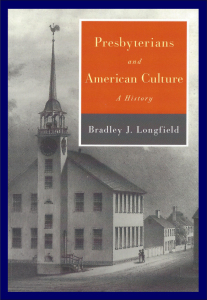Longfield Surveys Interface of Presbyterians and Culture, Part 1
 Bradley J. Longfield. 2013. Presbyterians and American Culture: A History. Louisville: Westminster John Knox Press.
Bradley J. Longfield. 2013. Presbyterians and American Culture: A History. Louisville: Westminster John Knox Press.
Review by Stephen W. Hiemstra
My first history class in college did not start out well. Not only did my bright, young professor from Yale not like my papers, he threatened to fail me if I signed up for the next class in the sequence. My constant questions in class clearly annoyed him. But I took his threat as a challenge and basically sat on his desk until he explained to me why my papers were not up to snuff, so to speak. The problem? I viewed history as chronology (A happened, then B happened, then C happened…) while he saw historical observations providing support for hypothesis testing (A and B happened causing C). We employed different historical methods in our thinking .
In his book, Presbyterians and American Culture, Bradley Longfield chronicles (surveys) historical events in the Presbyterian churches in America from the early 1700s through the present decade. By Presbyterians, Longfield means the denominations that today make up the Presbyterian Church (USA). By culture, Longfield follows Clifford Geertz seeing culture as “an historically transmitted patterning of meaning embodied in symbols” including “values, attitudes, perspectives, beliefs, and ideas”. This survey is motivated by a perceived identity crisis among Presbyterians brought about at least in part by how they have attempted to influence culture (xi-xiii).
Longfield is dean and a professor of church history at the University of Dubuque Theological Seminary (PCUSA) in Dubuque, Iowa. He writes in 7 chapters preceded by an introduction and followed by an Epilogue. The 7 chapters (vii) are:
Growing Together, Falling Apart: The Birth of American Presbyterianism (1-24);
New Church, New Nation (25-52);
A Christian America: Awakenings and Reform (53-90);
Divided Church, Divided Nation (91-116);
Crusading American, Crusading Church (117-148);
War at Home, War Abroad (149-174); and
Contested Boundaries: The Disestablishment of American Presbyterianism (175-200).
The appendix includes a helpful chart showing the relationships and dates of many of the Presbyterian denominations, including the most recent one—the Covenant Order of Evangelical Presbyterians (ECO)—which was organized in 2012. There is also a subject matter index.
One challenge with surveys arises in drawing inferences about general trends and causality. Are the observations presented symptomatic of the times or simply the things that are most easily described? While this question cannot be easily answered, it does point to the usefulness of the survey method—to identify interesting hypotheses worthy of further inquiry.
One such hypothesis concerns the role of confessions in the Presbyterian response to culture. For example, throughout most of the period covered by this study the Westminster Confession united Presbyterians in the Americas. It was written in 1640—just before period studied (3), was adopted early on as the primarily confessional document among Presbyterians (15), was the focus of proposed revisions (126), and remains in the Book of Confessions still in use today. Yet, the attitude about the confession changed dramatically in the 20th century. Serving first as a bulwark against liberalism in the early part of the century (142) and later serving merely as another confessional document, one of many, by the 1970s (196). Freed of its confessional moorings by the end of the century, the current Presbyterian identity crisis might easily be explained as a consequence of “confessional wanderlust”.
Longfield’s survey technique clearly goes beyond describing events easily documented. Of special interest are several sections that he devotes to Presbyterian outreach efforts in the eighteenth and nineteenth century to native Americans. David Brainard’s evangelism to the Crossweeksung Indians in New Jersey in 1746 focused on instruction in the Westminister Shorter Catechism, preaching, and children’s education (29). Presbyterian efforts to evangelize the Cherokee Indians included unsuccessful efforts to encourage their leaders to pass laws restricting polygamy, abortion, and divorce and encouraging Sabbath observance and patrilineal inheritance (82). Later in 1831 resulted in missionaries in Georgia being arrested because the more general mood of the nation during the Jackson presidency was to relocate the Cherokees to western lands, not to convert and educate them (85).
Longfield’s Presbyterians and American Culture is most useful for seminary students and Presbyterian pastors curious about historical controversies of the Presbyterian Church (USA). In part 2 of this review (on Wednesday March 11), I will look in more depth at a couple of these controversies.




